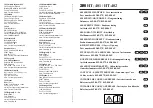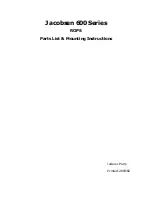
11
4. Operation Summary
4.1 Cabling and Starting-up
Before connecting to the mains, please ensure that your local
mains voltage (e.g. 230V in mainland Europe, 120V in the USA)
is suitable for the voltage input range of the included power
supply.
The relevant specs and safety symbols are printed on the rear
side of the unit.
Note: 24V power supply
The 24V DC power supply is a certified wide-range model,
capable of handling input voltages between 100V and 240V.
A substantial amount of research, effort and testing went into
the selection of this power supply. It is critical to the function
of the preamp – please don‘t use any other power supply!
Also please bear in mind that any device powered from a
power supply (as opposed to battery operation), may suffer
interference carried by the electricity supply itself. To avoid
this, always try and keep signal cables as short as possible.
We have opted for a „non-earthed power supply“ (class 2 with
protective insulation) in order to avoid unwanted earth or
ground loops that occur when using several earthed mains
powered devices in the signal chain
Please ensure that both the tone balance and the equalizer
level controls are in their middle position (centre detent)
and all other controls are turned all the way to the left. The
pushbuttons should be off, i.e. not pushed.
Make all signal cable connections as desired (e.g. instrument
or microphone to input, line out to amplifier input and maybe
DI out to the mixing desk input). Now you can connect the
unit to the power supply.
The green power control LED indicates operational readiness.
4.2 Level adjustment
The
colourizer 2
is equipped with a high-quality preamp
which can handle line and microphone signals and has there-
fore a wide input sensitivity range.
Using the
Attn-switch
, selects the preamp function to suit
your signal source.
Attn-switch pressed
is suitable for micro-
phones. (with condenser microphones please activate 24V
phantom power)
Attn-switch released
should be used for instrument pick-up
systems and most other signal sources.
The gain control is used to match the
colourizer 2
input stage
to your signal source, ensuring optimum function with the
best possible signal-to-noise ratio (SNR).
Having selected the appropriate preamp function with the
gain controls set fully counter clockwise (minimum gain), turn
up the gain whilst playing your instrument until the red clip
indicator lights up occasionally with heavy strumming.
Now turn down the gain control (or the volume control on the
source) by a tiny amount to allow additional headroom for
undistorted reproduction.
During play, the clip control LED should only flicker.
With line sources with a sufficient input signal level, the gain
controls will probably sit between minimum gain and the
10 o’clock position. It’s likely that in not pressed position the
setting will be significantly higher.
Finally the desired output level of the line output is controlled
by the volume control. Please note that some of the filter sta-
ges are active and will therefore affect the overall level setting
Note: Level adjustment
By setting the level correctly we mean that the signal level in
one or several devices in a signal chain is neither too high nor
too low.
This applies equally to all components of a unit (here tone,
enhancer or equalizer included).
Consequently, care must be taken that no part of the circuit is
overloaded, or that distortion is unintentionally added to the
signal. We have carefully designed the circuit to achieve this
objective whilst also providing potentiometers (gain, level,
volume) for „manual” intervention.
5. Functional Characteristics
5.1 DI level
The DI-out carries a balanced preamp signal. The DI level
control determines the preamp’s output signal level.
5.2 Phase
The phase switch allows reversal of the phase of the output
signal of the
colourizer 2
relative to the input signal by 180°,
thus matching it to the phasing of other devices in your signal
chain.
5.3 24V Phantom power
The 24V phantom power switch is located on the rear side of
the housing. This provides phantom power to the XLR input
for devices that require it eg condenser mics. The 24V phan-
tom supply of your AER device complies with the
DIN EN 61398 regulations in view of a 24V phantom power
supply. Please note the supplement text on page 7.5.4 Filter
network and filter stages
5.4.1 Tone Balance – How does it work?
The „tone balance“ is served by the two controls:
balance and intensity.
The intensity control determines the degree to which bass
and treble are increased simultaneously and are mixed to
the original signal (parallel mode). If the intensity control is
far over to the left (min, s. fig.), then the original signal is not
influenced (flat). Turning the control to the right
(—> mid —> max) mixes the relevant bass and treble mix to
the original signal.
The balance control influences the relationship between bass
and treble. If it is in middle setting, bass and treble are balan-
ced. The tone balance is now in equation. (s. fig. 1)
If you turn the balance control to the left (fig. 2), the bass
range is further increased, but the treble is decreased by max.
0dB.
A turning to the right (fig. 3) affects an increase in treble whilst
at the same time reducing the bass.
In its function and signal path the tone balance is delibera-tely
designed as a somewhat „different“ equalizer. It offers a com-
fortable way of giving the original signal more zip wit-hout
distorting it.
Especially on those occasions, when the equalizer has to be
used to suppress resonance or feedback.
Содержание Colourizer 2
Страница 1: ...1 Colourizer 2 Colourizer 2 Bedienungsanleitung UserManual 10 2020 ...
Страница 14: ...14 8 Block Diagram ...
Страница 15: ...15 ...


































